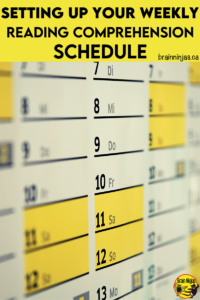
If you are struggling with reading instruction in your classroom, you’re not alone. Upper elementary teachers are often not trained in how to teach students to read, despite the fact all the students in their classroom are unlikely to be reading at grade level. Setting up a reading comprehension schedule is one way to get on track.
We designed our Weekly Reading Comprehension Skills specifically for our students. We needed reading material for science and social studies that were at the right reading level and needed to teach grammar and reading skills. You might want to read this post about how we came up with them: Add Great Content to Your Literacy Lessons.
Know Who Your Students Are, so You Can Set Up Your Weekly Reading Comprehension Schedule
First things first…know your students. One way we do this is through Learner Profile Surveys. We also do a Quick Reading Assessment. You can grab one in our Resource Library or we can send one to you when you sign up for our emails. If you want to read more about setting up Guided Reading groups, be sure to read Preparing for Your Guided Reading Lessons.
Once we know a little about our students, it is possible to decide which reading groups we will place them in. We start with reading levels just to get started so we can read with students, but generally, we look at students who are at grade level or below grade level.
Students at grade level use our Weekly Reading Skills activities in addition to the reading materials our school owns. We hand out the activities on Monday and do the mini-lessons with the class. Students work on these over the rest of the week. Students below grade level work on texts at their reading level along with the activities with support in reading groups together with the teacher. One day we will have activities written for them as well.
Students at grade level finish as many of the activities as possible independently, but these are reviewed in their reading groups so the skills can be reinforced.
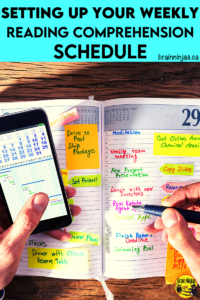
When a group is at the table, explicit reading instruction happens. This means reading the text passage, using the words and skills from the activities to show how they relate to the passage and practicing the skills.
Your Weekly Reading Comprehension Schedule Matters
Being consistent matters. The routines we put in place save us time, but they also provide comfort for students so they know the expectations.
Honestly, we never realized how closely linked learning prefixes, syllables and root words could be to understanding what is read. Before too long, our students started making connections between these activities to what they were reading. They started noticing they could break apart words on their own to help them decode and understand the meaning of unfamiliar words.
While a group works with the teacher at a table, the rest of the class is working on the activities as independently as possible, reading their levelled reading, silent reading material of their choice or working on reading activities assigned from Guided Reading. Sometimes we’ll have students working on a writing assignment or other class work we’re trying to complete.
As our class progresses, students develop the ability to work more independently, so these work sessions gradually become longer. In fact, we can usually work two half-hour reading group sessions along with a whole group mini-lesson each day.
Getting students to work independently can be a challenge, but it truly comes down to classroom management and assigning the right work. You might want to read this post: Are You Accidentally Teaching Helplessness?
Choose a Set
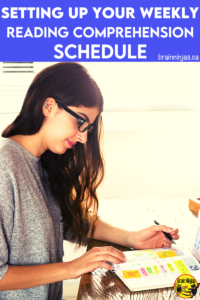
Choose one of the sets. We choose them by topic and try to link them to whatever we’re working on in Social Studies or Science, but it doesn’t always line up and that’s okay. You can try a free week: for Grade 4 Writing-On-Stone Provincial Park or Grade 5 Permafrost.
Each set comes with a digital version and a paper version to use for printing. They can be done in any order.
Grade Four Sets
Set 1: Natural Resources on TpT ($USD) or our BN Shop ($CAN)
Orphan Wells (Oil Energy) on TpT ($USD) or our BN Shop ($CAN)
Urban Agriculture on TpT ($USD) or our BN Shop ($CAN)
Mountain Pine Beetle (Forestry) on TpT ($USD) or our BN Shop ($CAN)
Watersheds (Clean Water) on TpT ($USD) or our BN Shop ($CAN)
Set 2: Wandering Waste on TpT ($USD) or our BN Shop ($CAN)
Whale Poop on TpT ($USD) or our BN Shop ($CAN)
Plastic Film on TpT ($USD) or our BN Shop ($CAN)
Pacific Garbage Patch on TpT ($USD) or our BN Shop ($CAN)
Waste Innovation on TpT ($USD) or our BN Shop ($CAN)
Set 3: Community Life on TpT ($USD) or our BN Shop ($CAN)
Quality of Life on TpT ($USD) or our BN Shop ($CAN)
Urban Origins on TpT ($USD) or our BN Shop ($CAN)
Rural Ghost Towns on TpT ($USD) or our BN Shop ($CAN)
Tourism on TpT ($USD) or our BN Shop ($CAN)
Set 4: Light and Shadow on TpT ($USD) or our BN Shop ($CAN)
Colour Blindness on TpT ($USD) or our BN Shop ($CAN)
Shadow Puppets on TpT ($USD) or our BN Shop ($CAN)
Rainbows on TpT ($USD) or our BN Shop ($CAN)
Ultraviolet Light on TpT ($USD) or our BN Shop ($CAN)
Set 5: Heritage Objects on TpT ($USD) or our BN Shop ($CAN)
Frank Slide on TpT ($USD) or our BN Shop ($CAN)
Artifacts on TpT ($USD) or our BN Shop ($CAN)
Fossils on TpT ($USD) or our BN Shop ($CAN)
Okotoks on TpT ($USD) or our BN Shop ($CAN)
Set 6: Simple Machines on TpT ($USD) or our BN Shop ($CAN)
Indigenous Tools on TpT ($USD) or our BN Shop ($CAN)
Nature’s Machines on TpT ($USD) or our BN Shop ($CAN)
Silly Machines on TpT ($USD) or our BN Shop ($CAN)
Mechanical Watches on TpT ($USD) or our BN Shop ($CAN)
Set 7: Heritage Sites on TpT ($USD) or our BN Shop ($CAN)
Father Lacombe Chapel on TpT ($USD) or our BN Shop ($CAN)
Buffalo Jumps (Head-Smashed-In Buffalo Jump) on TpT ($USD) or our BN Shop ($CAN)
John Ware’s Cabin on TpT ($USD) or our BN Shop ($CAN)
Ukrainian Heritage Village on TpT ($USD) or our BN Shop ($CAN)
Writing-On-Stone Provincial Park (this is a free lesson to try) on TpT ($USD) or our BN Shop ($CAN)
Set 8: Peculiar Plants on TpT ($USD) or our BN Shop ($CAN)
Sacred Plants on TpT ($USD) or our BN Shop ($CAN)
Carnivorous Plants on TpT ($USD) or our BN Shop ($CAN)
Invasive Plants on TpT ($USD) or our BN Shop ($CAN)
Xeriscaping on TpT ($USD) or our BN Shop ($CAN)
Grade Five Sets
Set 1 Becoming Canada on TpT ($USD) or our BN Shop ($CAN)
Patriation on TpT ($USD) or our BN Shop ($CAN)
Canadian Flag on TpT ($USD) or our BN Shop ($CAN)
Statute of Westminster on TpT ($USD) or our BN Shop ($CAN)
Charter of Rights on TpT ($USD) or our BN Shop ($CAN)
Set 2 Weather Wonders on TpT ($USD) or our BN Shop ($CAN)
Weather Forecasting on TpT ($USD) or our BN Shop ($CAN)
Tornados on TpT ($USD) or our BN Shop ($CAN)
Permafrost (You can try this one for free) on TpT ($USD) or our BN Shop ($CAN)
Fabrics & Fibres on TpT ($USD) or our BN Shop ($CAN)
Climate Migration on TpT ($USD) or our BN Shop ($CAN)
Set 3 Confederation on TpT ($USD) or our BN Shop ($CAN)
Macdonald & Cartier on TpT ($USD) or our BN Shop ($CAN)
Expanding West on TpT ($USD) or our BN Shop ($CAN)
Excluded Voices (Indigenous People) on TpT ($USD) or our BN Shop ($CAN)
Nunavut on TpT ($USD) or our BN Shop ($CAN)
Set 4 Canadian Chemistry on TpT ($USD) or our BN Shop ($CAN)
Peanut Butter on TpT ($USD) or our BN Shop ($CAN)
Green Ink on TpT ($USD) or our BN Shop ($CAN)
Fireworks on TpT ($USD) or our BN Shop ($CAN)
Insulin on TpT ($USD) or our BN Shop ($CAN)
Set 5 Canadian Injustices on TpT ($USD) or our BN Shop ($CAN)
Africville on TpT ($USD) or our BN Shop ($CAN)
Chinese Head Tax on TpT ($USD) or our BN Shop ($CAN)
Internment Camps on TpT ($USD) or our BN Shop ($CAN)
Komagata Maru on TpT ($USD) or our BN Shop ($CAN)
Set 6 Eclectic Electricity on TpT ($USD) or our BN Shop ($CAN)
Electric Eels on TpT ($USD) or our BN Shop ($CAN)
Internet Data Centres on TpT ($USD) or our BN Shop ($CAN)
Lightning on TpT ($USD) or our BN Shop ($CAN)
Electric Cars on TpT ($USD) or our BN Shop ($CAN)
Set 7 Canadian Groundbreakers on TpT ($USD) or our BN Shop ($CAN)
Willie O’Ree on TpT ($USD) or our BN Shop ($CAN)
Elsie MacGill on TpT ($USD) or our BN Shop ($CAN)
Stanley G. Grizzle on TpT ($USD) or our BN Shop ($CAN)
Mary Two-Axe Earley on TpT ($USD) or our BN Shop ($CAN)
Set 8 Wild Wetlands on TpT ($USD) or our BN Shop ($CAN)
Busy Beavers on TpT ($USD) or our BN Shop ($CAN)
Making Wetlands on TpT ($USD) or our BN Shop ($CAN)
Uses of Peat on TpT ($USD) or our BN Shop ($CAN)
Urbanization on TpT ($USD) or our BN Shop ($CAN)
Grade Six Sets
Set 1 Canadian Space Tales on TpT ($USD) or our BN Shop ($CAN)
Canadian Astronauts on TpT ($USD) or our BN Shop ($CAN)
Canadian Space Technology on TpT ($USD) or our BN Shop ($CAN)
Constellations (You can try this one for free) on TpT ($USD) or our BN Shop ($CAN)
Pluto on TpT ($USD) or our BN Shop ($CAN)
Space Junk on TpT ($USD) or our BN Shop ($CAN)
Decide which students will do the activity.
Realistically, this means it will depend on whether your students are in class or learning online. You can definitely group your students by availability during this pandemic teaching period. Do whatever works best for you as this schedule is just a suggestion based on what worked for us.
Week 1
Purpose: To introduce the activities and meet with reading groups for an introduction.
Week 1: Day 1
Hand out the activity set to all of your students. If you are using the paper version, consider getting a binder or duotang assembled. Students can keep these pages inside this until they are ready to hand them in (or the whole thing can be handed in).
If your students are using the digital version, we recommend you make a copy of the file and then assign that copy to your students via Google Classroom. We always label the assignment with the start date and then add a due date. This keeps things organized in the stream. We also called them WRS in our classroom and with our students. In Google Classroom the weekly assignment looks like: WRS Sept 9- Patriation.
Labeling it this way makes it easy for students to find and they always know what to look for.
Go Over the Expectations and What to Do
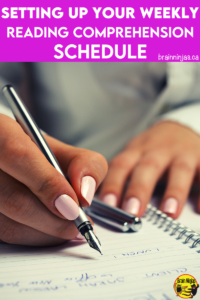
Explain that the purpose the weekly skills is to practice and use what is learned in reading groups. Explain that the groups will be mixed up based on what students need to learn, so groups might change regularly.
To keep it simple, we number our groups 1-6 and write the students’ names. We put these on sticky notes and keep them on our reading board. We use sticky notes because they are temporary and easy to replace. Students get used to looking for their group each week and expect changes.
Explain where the assignment will be each week and that when it’s time to work students will be expected to get their materials themselves. This will take practice each week until they get it.
Tell your students that the order they complete the assignments doesn’t matter, but often they will need to have read the reading passage in order for everything to make sense. We intentionally didn’t want the reading passage to prevent students from being able to do the activities and vice versa.
The mini-lesson for reading is best done in small groups, so save it for that, but start with lesson #2 and work through a few of the mini-lessons. Each lesson is short and so is the work on the slide/page. Students can try out each activity, but keep going through as many of the mini-lessons as possible. Students will have a chance to return to each activity to complete it later.
Ninja Note
Mini-lessons are supposed to be mini (short and sweet). They focus on one small aspect of a skill. For example, if the skill is about comma use, the mini-lesson and activity will focus on ONE use for a comma. Do not expand the lesson beyond the one skill. This focus is designed to help students learn and apply specific aspects and over time (week after week) they will build up a wealth of knowledge about all the uses of commas.
If you plan to meet with a reading group during this first session, go ahead. Ask the rest of the students to work on the activities or read silently while you work with the group.
Start practicing “no interruptions” when you’re working with a group. Keep the group meetings short (no more than 10 minutes) this week.
Week 1: Day 2
Pick up on the mini-lessons where you left off and do as many as you can, giving students an opportunity to try out each activity, but not so much time they finish them all.
Read with a new group and give students a chance to work independently up to the Activity #10 or the last mini-lesson you completed (whichever is less). When students have finished their work, they can read silently.
The purpose of reading silently is just to help students practice working independently-more importantly letting you work with small groups without interruptions.
Week 1: Day 3
Finish any mini-lessons you haven’t done. If you’re going to give students extra materials like paper to complete the bonus activities, be clear about where students will be able to find these materials. You may need to teach a mini-lesson for some of the bonus activities.
We explain that students should not be working on the bonus activities until the regular activities are completed. You will need to make a decision about the bonus activities for your students and then communicate this to your class.
Meet with a reading group while your students work independently. When they finish they can read silently.
Week 1: Day 4
If you have any mini-lessons left, finish teaching these.
Meet with your reading group and let students work independently.
Week 1: Day 5
If your students need more time to finish the activities, give them more work time. Meet with a reading group.
Review the activities to check if students had any difficulties. You may need to review an activity and try the mini-lesson again if many students have struggled.
We do not usually mark each page. Instead, have students mark their own work to see what they need help with. This can help you focus on what you will need to work on during the next week.
Week 2
Purpose: To get students into the routine of weekly reading skills.
Week 2: Day 1
Remind students expectations for getting started on the new activities. Let your students do any activities they already know how to do (or even try out some of the new ones because the instructions are on the page/slide).
Review that students need to get their own materials and try to work on their own as best they can.
Start with the new mini-lessons. You should only be doing the ones that are new (about three-quarters will be).
Meet with a reading group.
Week 2: Day 2
Finish any mini-lessons that are left.
Meet with a reading group while students work independently on the activities or read silently.
Week 2: Days 3-5
Review any mini-lessons if there are any that are still new to students or need practice. Meet with each of the reading groups.
Week 3
Purpose: To practice the routine, practice more independence and start the real work in reading groups.
Meaningful reading with your students in small groups will start. This means students should be working as independently as possible so you are not interrupted. You will need to be very clear about not being interrupted when you are working with small groups.
Week 3: Day 1
Introduce any new mini-lessons. Now that many of the lessons have been taught, there should only be one to three new lessons each week.
Meet with one of the small groups. You might wish to group them by reading level or comprehension skill that you want to focus on during the group work time.
Week 3: Day 2-5
Students will work independently on the rest of the work. You will meet with small groups.
This is when you might introduce other reading activities. These might include having students read on their own with their own choice of reading material or assigned reading at the students’ reading levels.
You might wish to have students working on other things so they can practice working independently while you meet with groups. These might be projects or tasks from other subject areas. If you need ideas, you might want to read our What Are the Other Kids Doing During Guided Reading?
Week 4
Purpose: Practicing the routine so that more work gets done.
Week 4: Day 1-5
This week should be the first week where the majority of your time is spent working with small groups while the remainder of your class works as independently as possible.
You may need to teach a mini-lesson, but we’ve started teaching our students to skip the one they don’t know how to do. We have a piece of chart paper on the front whiteboard where students can write the Activity Number (found on the top right of each slide or page activity) if they need help. We can then easily see which lessons need to be taught or reviewed for the class.
The mini-lesson can be taught any time during the week, but we recommend earlier in the week so that students don’t get stuck.
What Now?
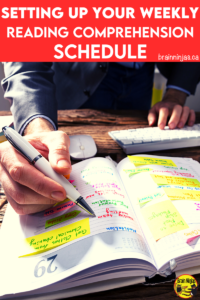
Well, now your routine should be in place enough that you can mix in your regular Guided Reading program (depending on what your school has access to or uses) along with all your Language Arts instruction. Use your routine to introduce one new thing each week as you go.
By practicing many of the grammar and reading comprehension activities regularly during your small group instruction, you can then spend some of your other instructional time finetuning based on the needs of your students.
Are you looking for other Language Arts ideas?
- Give Your Reading Instruction an Easy Twist
- How to Teach Reading With Book Clubs
- How to Use Google Meet to Run a Book Club
- Research Skills: How to Teach Text Features
- How to Celebrate Poem in Your Pocket Day
- Practical Strategies for Reluctant Readers
- Help! I Don’t Know How to Do Guided Reading
- Help! What Do the Other Kids Do During Guided Reading?
- Preparing For Guided Reading Groups
- How to Run Your Guided Reading Instruction
- Challenge Your Students with Writing Activities Every Day
- 22 Amazing Ways to Use Word Wall Words
We are constantly looking for new ways to make these lessons work. We already have a list of things we want to do (differentiated reading levels for one), but if you have a suggestion (or a question to help make this work in your classroom) we’d love to hear it. Let us know in the comments below.

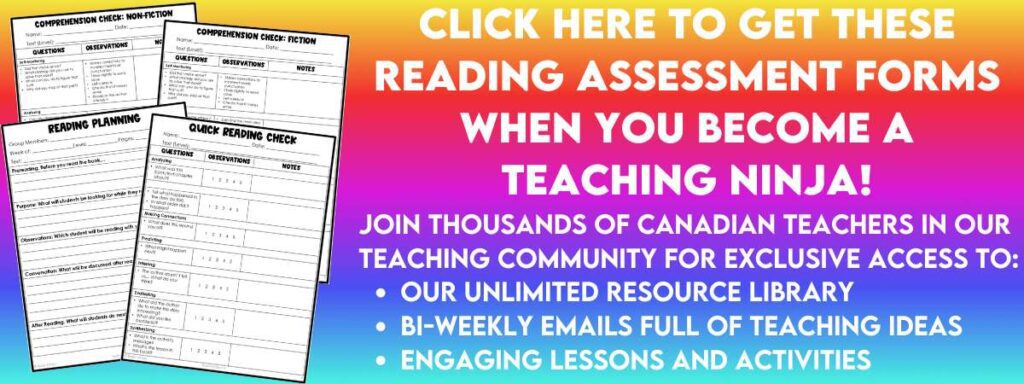
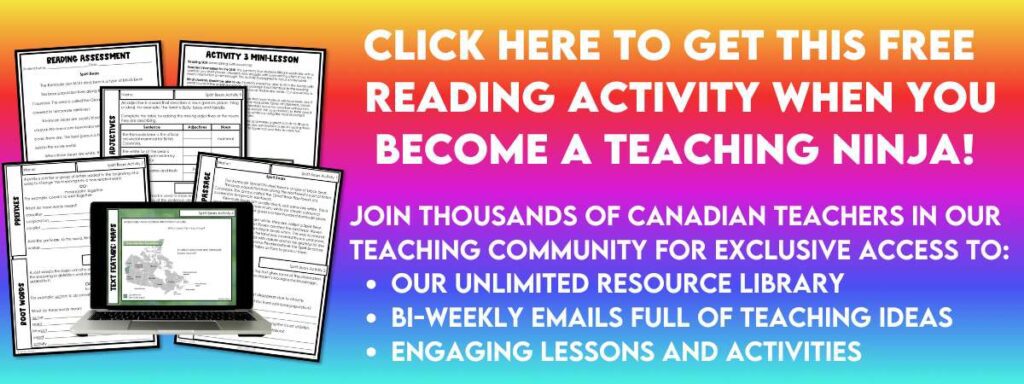
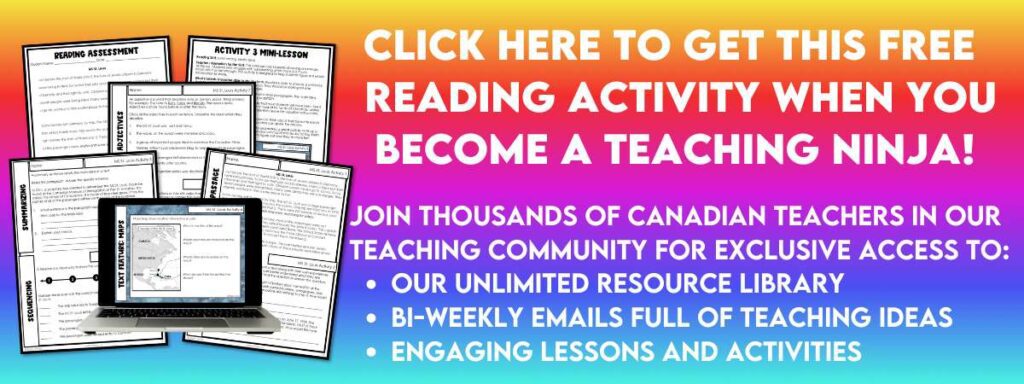






This is really helpful! Thank you! 🙂